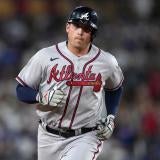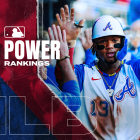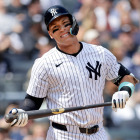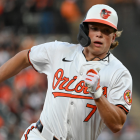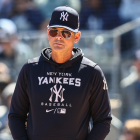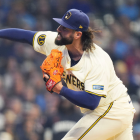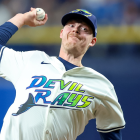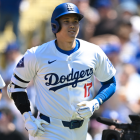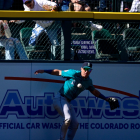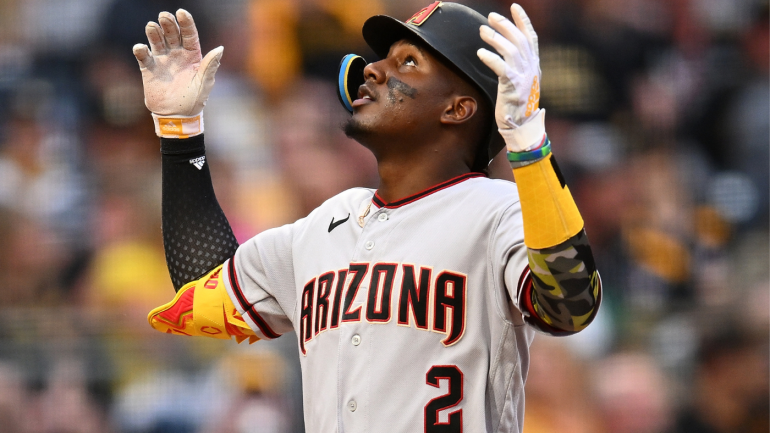
Here's a surprise: the Arizona Diamondbacks entered Tuesday with the third-best record in the National League, at 28-20, trailing only the Atlanta Braves and the Los Angeles Dodgers. It's still early, and their modest run differential (+15) doesn't support their 94-win pace. Even so, few outside of Arizona expected there to be less space between the Dodgers and Diamondbacks (1 1/2 games) at this stage of the season than between the Diamondbacks and the San Diego Padres (6 1/2 games).
While it's become commonplace to overlook the Diamondbacks -- they haven't made the postseason since 2017, and they haven't advanced to even the League Championship Series since 2007 -- we wanted to use this opportunity to examine their performance through the first quarter of the season. Scroll slowly with us, won't you, as we highlight three of the most notable dynamics at play in Arizona.
1. Perdomo, Carroll coming up big
If we had told you back in March that a young Diamondbacks position player would lead them in both OPS+ and Wins Above Replacement, you would've been justified to guess that the player in question would be Corbin Carroll. There's a difference between being justified and being correct, however, and you would be learning that the hard way. That's because 23-year-old shortstop Geraldo Perdomo has managed to top Carroll (and the rest of his teammates) in both of those statistics.
Geraldo Perdomo with the equalizer!! pic.twitter.com/n2MJG7n6T1
— Bally Sports Arizona (@BALLYSPORTSAZ) May 19, 2023
Perdomo had a brutal first full year in the majors last season, batting .195/.285/.262 with nearly as many strikeouts (103) as total bases (113) in 148 games. The Diamondbacks stuck with him, either by choice or necessity, and it's paying off. Through his first 37 games, he's hitting .317/.418/.529 (161 OPS+). What's more is Perdomo entered the weekend as one of five batters who ranked in the 90th percentile or better in both contact and chase rate. The others? Adley Rutschman, Steven Kwan, Anthony Rendon, and J.P. Crawford. That's fine company, in our estimation.
Perdomo has nearly matched last season's home-run total in 114 fewer games, but his emergence has less to do with slugging the ball (he's hitting the ball hard less frequently) and more to do with his aforementioned commitment to owning the zone. He's raised his in-zone contact rate from 83.7% to 90.1%, and he's hitting the ball in the proverbial sweetspot (between 10 and 30 degrees) about 33% of the time. Factor in Perdomo's well-regarded defense, and you have a nifty player.
Corbin Barrels! 👏 pic.twitter.com/eWhMmBZhf5
— Arizona Diamondbacks (@Dbacks) May 17, 2023
As for Carroll, he's doing quite well, too. We ranked him as the No. 2 prospect in the land entering the spring in part because of the well-rounded nature of his game. He's lived up to that billing, producing a Baseball Savant page that features more pink and red than a CVS aisle around Valentine's Day. Overall, Carroll is hitting .275/.371/.490 (137 OPS+) with seven home runs and 13 stolen bases (on 15 attempts). Additionally, his 1.5 Wins Above Replacement ranks first among all big-league rookies.
2. Varsho trade paying off
Speaking of young players performing, how about 23-year-old backstop Gabriel Moreno? When Carson Kelly fractured his forearm late in the spring, it was worth worrying that the Diamondbacks might push Moreno into a greater role than he was prepared to handle. So much for that. Moreno has hit .301/.328/.374 (95 OPS+) through his first 37 games. His framing could use some improvement with time (he ranks in the 50th percentile), but he's shown off an impressive arm and ranks second in Statcast's new caught stealing above average metric:
Una noche normal para Gabriel Moreno. pic.twitter.com/JsBfBOPyBB
— MLB Venezuela (@MLBVenezuela) May 12, 2023
Moreno was the key part of the return in last December's trade that sent Daulton Varsho to the Toronto Blue Jays, but he wasn't the only player Arizona fetched in that swap. They also landed veteran outfielder Lourdes Gurriel Jr., who has hit .321/.376/.562 (156 OPS+) so far this season. Varsho, for his part, entered Tuesday sporting an 81 OPS+, or well beneath his established levels.
These things are fluid and there's no reason to believe that Varsho or Gurriel will maintain their current paces heading forward. With that in mind, it is fair to note that, so far, the Diamondbacks have benefited more from that trade than the Blue Jays have -- to the extent that it's one of the main reasons they've played so well to date.
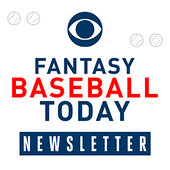
Fantasy Baseball Today Newsletter
Your Cheat Code To Fantasy Baseball
You're destined to gain an edge over your friends with advice from the award-winning FBT crew.
Thanks for signing up!
Keep an eye on your inbox.
Sorry!
There was an error processing your subscription.
3. Gallen, Kelly covering for rough patches
Zac Gallen encountered a hiccup last time out against the Pittsburgh Pirates, surrendering eight earned runs in 3 2/3 innings. That's notable because he had allowed six earned runs total in his previous seven starts, a stretch that included 28 consecutive scoreless innings. Despite Gallen's blow-up against the Pirates, he is still one of two D-Backs starters with an ERA below 3.00. Merrill Kelly is the other.
It's a good thing that Gallen and Kelly are having All-Star-caliber seasons, because the rest of Arizona's rotation has been spotty. For the time being, at least, the Diamondbacks have landed on a combination of Brandon Pfaadt, Ryne Nelson, and Tommy Henry to fill out their starting five. The results have been mixed:
| Split | GS | IP | ERA | SO/BB |
|---|---|---|---|---|
Gallen/Kelly | 20 | 118.1 | 2.97 | 3.74 |
Everyone else | 28 | 141.2 | 5.97 | 1.39 |
Pfaadt turned in the best start of his brief career last time out after tweaking his approach. To these eyes, he seems like the youngster with the best chance of sticking heading forward. Granted, that isn't the highest bar to clear: Henry nearly has a higher ERA than strikeout per nine rate, and Nelson doesn't appear to be skilled enough at managing contact or missing lumber to profile as a starter long-term.
If the Diamondbacks come to the same conclusions, they have plenty of other young options they can slot into the back of their rotation over the course of the summer: at Triple-A alone, they have Drey Jameson (who has already started several games for them this season), Blake Walston, Bryce Jarvis, and Slade Cecconi. Then again, with how they've performed to date, perhaps Arizona's front office will forgo more on-the-job training in favor of trading for an established starter at the deadline.







